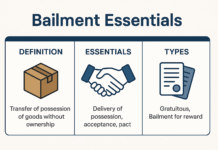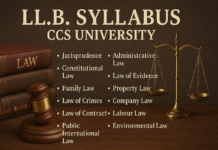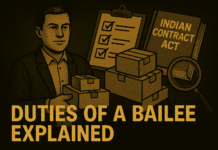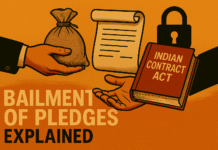Who is unpaid seller? Discuss his rights in detail. Or What do you mean by an unpaid seller’s right of lien? When this right can be exercised and when it comes to an end ? Distinguish it from a right of stoppage in transit.
In the realm of commercial transactions involving the sale of goods, the scenario where a seller hasn’t received the full payment for the goods delivered (or yet to be delivered) is not uncommon. The Sale of Goods Act provides specific rights to such a “seller,” aptly termed an “unpaid seller,” to protect their interests. This article delves into the definition of an unpaid seller and meticulously examines their crucial rights, particularly the right of lien and the right of stoppage in transit, while also distinguishing between these two important remedies.
Who is an ‘Unpaid Seller’? (Section 45)
According to Section 45 of the Sale of Goods Act, a seller is considered an “unpaid seller” under the following circumstances:
- When the whole of the price has not been paid or tendered. Even partial non-payment qualifies the seller as an unpaid seller.
- When a bill of exchange or other negotiable instrument was received as conditional payment, and it has subsequently been dishonoured. If the agreed mode of payment fails, the seller reverts to the status of an unpaid seller.
The definition of a “seller” in this context is broad and includes anyone in the position of a seller, such as:
- An agent of the seller.
- A consignor.
- An agent who has personally paid or is directly responsible for the price.
It’s crucial to note that if the buyer has offered the price, and the seller has refused to accept it, the seller cannot claim the status of an unpaid seller.
Rights of an Unpaid Seller (Section 46)
Section 46 of the Sale of Goods Act grants the following significant rights to an unpaid seller, even if the ownership of the goods has passed to the buyer:
- Lien on the goods (Right to retain possession).
- A right of stoppage in transit (Right to regain possession while goods are in transit).
- Right of re-sale.
- Withholding delivery (where the property in the goods has not passed to the buyer).
This article will primarily focus on the right of lien and the right of stoppage in transit, as requested.
Unpaid Seller’s Right of Lien (Sections 47-49)
The right of lien for an unpaid seller is the right to retain possession of the goods until the buyer pays or tenders the full price. This right is a powerful tool for the seller to ensure payment.
When Can the Right of Lien Be Exercised? (Section 47)
An unpaid seller who is in possession of the goods can exercise their right of lien in the following situations:
- Where the goods have been sold without any stipulation as to credit. If there was no agreement for a credit period, payment is due upon delivery, and the seller can hold onto the goods until payment.
- Where the goods have been sold on credit, but the term of the credit has expired. Once the agreed credit period is over and payment hasn’t been made, the seller can exercise their lien.
- Where the buyer becomes insolvent. If the buyer is declared bankrupt or is unable to pay their debts, the unpaid seller can retain possession of the goods, even if a credit period was initially agreed upon.
It’s important to note (Section 47(2)) that the seller can exercise their right of lien even if they are holding the goods as an agent or bailee for the buyer. The crucial factor is the actual possession of the goods by the seller. Furthermore, the seller doesn’t necessarily need to be the owner of the goods to exercise this right.
If an unpaid seller has made a part delivery of the goods (Section 48), they can exercise their lien on the remaining goods unless the part delivery was made under circumstances indicating an agreement to waive the lien on the rest.
Nature and Extent of the Right of Lien:
- Dependence on Possession: The lien is contingent upon the seller having actual possession of the goods. It’s not based on ownership or title. Even if the seller has parted with documents capable of transferring title (like a bill of lading or delivery order), the lien is not lost as long as they retain physical possession.
- Extent to the Whole Goods: The unpaid seller’s lien extends to all the goods in their possession related to the contract. They are not obligated to deliver a portion of the goods upon partial payment if they choose to exercise their lien on the remainder for the outstanding balance.
Termination of the Right of Lien (Section 49)
The unpaid seller loses their lien on the goods in the following circumstances:
- When the seller delivers the goods to a carrier or other bailee for the purpose of transmission to the buyer without reserving the1 right of disposal. Once the goods are out of the seller’s possession and in the hands of a third party for delivery to the buyer, the lien is lost.
- When the buyer or their agent lawfully obtains possession of the goods. If the buyer or someone authorized by them takes lawful possession, the seller’s right of retention ends.
- By waiver thereof. The seller can explicitly or implicitly waive their right of lien. This could be through an agreement or conduct that clearly indicates an intention to relinquish the right.
It’s important to note that the lien is not lost merely by reason that the seller has obtained a decree for the price of the goods. Even after obtaining a court order for payment, the seller can still exercise their lien if they remain in possession of the goods.
Unpaid Seller’s Right of Stoppage in Transit (Sections 50-52)
The second crucial right of an unpaid seller is the right of stoppage in transit. This right becomes relevant when the seller has parted with the possession of the goods, but the buyer has not yet received them, and the buyer has become insolvent.
When Can the Right of Stoppage in Transit Be Exercised? (Section 50)
Section 50 explicitly states that an unpaid seller who has parted with the possession of the goods has the right to stop them in transit if the buyer becomes insolvent. This means the seller can resume possession of the goods as long as they are in the course of transit and retain them until payment or tender of the price.
When Does the Right of Stoppage Arise?
The right of stoppage in transit arises precisely when the seller’s lien is lost, i.e., when the goods have left the seller’s actual possession. It deals with the intermediate stage where the goods are no longer with the seller but haven’t yet reached the buyer.
The right allows the seller to intercept the goods while they are in the possession of a carrier (like a transport company) or lodged at any place during their transmission to the buyer. The seller can then resume possession and hold onto the goods until the price is paid.
Conditions for Exercising the Right of Stoppage in Transit:
- The seller must be unpaid: Similar to the right of lien, the price must be wholly or partly unpaid. The fact that credit was initially given is irrelevant if the buyer becomes insolvent before the credit period expires.
- The buyer must have become insolvent: This is the critical condition that triggers the right of stoppage in transit. The insolvency must occur while the goods are in transit.
- The goods must be in transit: This is the essential element. Transit begins when the seller delivers the goods to a carrier for transportation to the buyer and ends when the buyer or their agent takes possession of them.
- The seller must not be prevented by any other provision of the Act: For instance, if the buyer has, in the meantime, obtained possession of the document of title (like a bill of lading) and transferred it for value to a bona fide purchaser, the seller’s right of stoppage in transit might be defeated (Sections 30(2) and 53(1)).
How is Stoppage in Transit Effected? (Section 52)
An unpaid seller can effect stoppage in transit in two ways:
- By taking actual possession of the goods. The seller can physically intercept and take control of the goods.
- By giving notice of their claim to the carrier or other bailee in whose possession the goods are. Upon receiving such notice, the carrier or bailee is obligated to re-deliver the goods to the seller. The seller is responsible for the expenses of this re-delivery.
Difference Between Lien and Stoppage in Transit
While both lien and stoppage in transit are rights available to an unpaid seller, they differ in several key aspects:
| Feature | Unpaid Seller’s Lien | Unpaid Seller’s Right of Stoppage in Transit |
| Buyer’s Status | Can be exercised whether the buyer is solvent or insolvent. | Can only be exercised when the buyer is insolvent. |
| Seller’s Possession | Exercisable as long as the seller is in possession of the goods. | Exercisable when the seller has parted with possession but the buyer hasn’t received them. |
| Goods Location | Goods are physically with the seller. | Goods are in the course of transit, typically with a carrier or bailee. |
| Commencement | Arises when the price is due and unpaid, and the seller has possession. | Commences when the seller delivers the goods to a carrier for transmission to the buyer. |
| Termination | Ends when the seller loses possession of the goods. | Ends when the buyer or their agent takes possession of the goods. |
Conclusion
The rights of an unpaid seller, particularly the right of lien and the right of stoppage in transit, are vital safeguards in commercial transactions. The right of lien empowers the seller to retain possession until payment when they haven’t yet relinquished control, while the right of stoppage in transit provides a crucial remedy when the goods are on their way to an insolvent buyer. Understanding the nuances of when these rights can be exercised and when they cease is essential for both sellers and buyers to navigate their obligations and protect their interests under the Sale of Goods Act. These provisions ensure a degree of security for sellers in the face of non-payment or the financial instability of the buyer.













